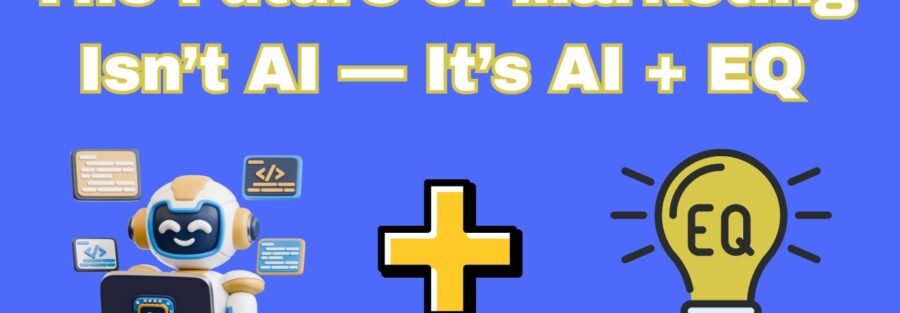The Future of Marketing Isn’t AI — It’s AI + EQ
Table of Contents
Introduction: The Hype vs. the Reality
Why AI Alone Isn’t Enough
The Role of EQ in Modern Marketing
How AI and EQ Work Hand in Hand
Real-World Examples of AI + EQ in Action
Humanized Automation: The Future of Marketing
Conclusion: People First, Always
1. Introduction: The Hype vs. the Reality
Artificial Intelligence (AI) has transformed marketing in remarkable ways. Marketers today use AI to analyze customer data, predict buying patterns, automate campaigns, and deliver hyper-personalized experiences at scale. These tools save time, cut costs, and sharpen performance — making it possible for brands to reach millions with precision.
But here’s the catch: AI is powerful, yet incomplete. While it tells us what customers are doing, it rarely explains why they’re doing it. A predictive algorithm might say a customer is “likely to churn,” but it won’t explain the emotion behind the decision — stress, frustration, or even fear of commitment.
That’s where Emotional Intelligence (EQ) comes in. EQ, the ability to recognize, understand, and respond to emotions, adds empathy, trust, and humanity to brand interactions.
The future of marketing isn’t about choosing between AI or EQ. It’s about combining both to create data-driven strategies that still feel deeply human.
2. Why AI Alone Isn’t Enough
AI is extraordinary at crunching numbers. It can analyze massive datasets in seconds, spot patterns, and optimize campaigns more effectively than any human.
For example, AI can:
- Predict when a customer is likely to make a purchase.
- Send marketing emails at the perfect time of day.
- Recommend products based on browsing history.
And yet, AI misses something fundamental: context.
Imagine a customer abandons their cart. AI might assume it’s because of pricing or lack of urgency. But in reality, maybe their child cried in the background, or they felt overwhelmed and needed more time. No algorithm can fully capture those moments of hesitation.
This is why AI-only campaigns often feel transactional. They may reach the right customer at the right moment, but if the tone feels robotic, they fail to build trust.
Numbers explain patterns. But only emotions explain people.
3. The Role of EQ in Modern Marketing
EQ ensures that marketing stays human-centered. While AI provides the data, EQ interprets the feelings behind it.
Think about your own experiences. You may not remember every ad you’ve seen, but you’ll remember how certain brands made you feel. That emotional connection — trust, joy, or relief — drives loyalty far more than discounts or offers.
Here’s how EQ strengthens marketing:
- Empathy in Messaging: Instead of “Buy this now,” EQ reframes to “We understand your challenge — here’s how we can help.”
- Trust in Relationships: Customers prefer brands that acknowledge their struggles, not just their spending power.
- Cultural Sensitivity: EQ ensures messaging respects diverse values and avoids missteps AI alone might overlook.
In short, EQ transforms campaigns from being product-focused to being people-focused.
4. How AI and EQ Work Hand in Hand
The magic happens when AI and EQ complement each other.
- AI spots patterns, EQ gives them meaning.
- AI scales communication, EQ ensures it feels authentic.
- AI saves time, EQ saves trust.
Some examples:
- Shopping for Baby Products: AI notices frequent diaper purchases. Without EQ, it spams promotions. With EQ, the message changes: “Parenthood can be overwhelming — here’s how we can make life easier.”
- Customer Service: Chatbots powered by AI handle common questions. When emotions run high, EQ calls for a human agent to listen and rebuild trust.
- Content Creation: AI drafts multiple ads. EQ ensures they align with cultural nuance and human values.
AI delivers efficiency. EQ delivers connection. Together, they create meaningful engagement.
5. Real-World Examples of AI + EQ in Action
Healthcare
AI sends appointment reminders. EQ reshapes the message into reassurance: “We know health journeys can feel overwhelming. Just a reminder: we’re here with you tomorrow.”Retail
AI recommends items based on browsing history. EQ refines it for eco-conscious shoppers: “Made sustainably with 100% recycled materials — better for you and the planet.”Education
AI tracks learning performance. EQ reframes feedback with encouragement: “You’ve improved 20% this week — keep going!”Travel & Hospitality
AI suggests destinations. EQ adds emotion: “Remember the sense of adventure you loved last time? Here’s your next journey.”
Across industries, one truth stands out: AI delivers intelligence, EQ delivers heart.
6. Humanized Automation: The Future of Marketing
We are entering an age of humanized automation.
The most successful brands won’t automate everything. Instead, they’ll know what to automate and when to humanize.
- AI handles repetitive, data-heavy tasks like audience segmentation or campaign timing.
- Humans step in where empathy, creativity, and storytelling are needed.
AI frees marketers from operational burdens, while EQ ensures automation never feels cold or robotic.
Think of AI as the engine and EQ as the steering wheel. One powers the journey, the other guides it toward meaningful connection.
The future of marketing will belong to those who balance both — automation for efficiency, empathy for depth.
7. Conclusion: People First, Always
AI has already reshaped the marketing landscape. But it can never replace the timeless power of human connection.
EQ ensures campaigns resonate emotionally, conversations build trust, and brand loyalty endures. Customers may appreciate AI-driven personalization, but they remain loyal to brands that make them feel valued.
The future belongs to businesses that embrace both — AI for precision, EQ for empathy. Because marketing has never been about algorithms. It has always been about people — their dreams, their fears, and their stories.
AI may amplify your message. But EQ ensures it’s remembered.
The future isn’t just Artificial Intelligence.
The future is Artificial + Emotional Intelligence.

